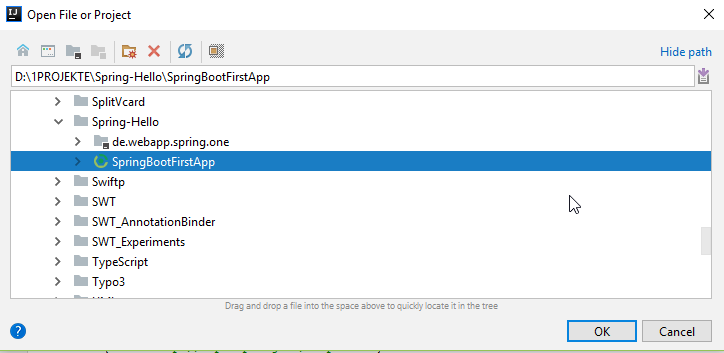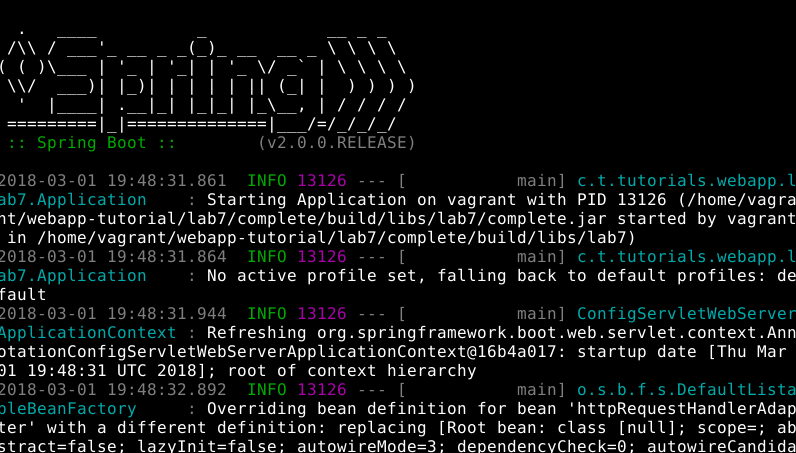Table of Contents
Spring Boot
Spring boot - is a Java framework, which claims to retrieve the default configurations from the libraries loaded to the path.
Rest Controller
Logging the exposed endpoints. To log the exposed endpoints the change in the application.properties is required:
application.properties
logging.level.web=TRACE logging.level.org.springframework.web=TRACE
Example output
12:14:48.398 [main] TRACE o.s.w.s.m.m.a.RequestMappingHandlerMapping
i.d.l.d.g.RestGroupController:
{GET [/rest/, /rest/groups]}: index(String,Optional)
{POST /rest/groups, consumes [application/json]}: createGroup(Group)
{POST /rest/groups/{groupId}/member}: addUserToGroup(String,String)
{DELETE /rest/groups, consumes [application/json]}: deleteRole(String)
{GET [/rest/, /rest/groups/member/{memberId}]}: groupsByMember(String)
{GET [/rest/, /rest/groups/{id}]}: groupById(String)
{DELETE /rest/groups/{groupId}/member}: removeUserFromGroup(String,String)
12:14:48.418 [main] TRACE o.s.w.s.m.m.a.RequestMappingHandlerMapping
i.d.l.d.r.RestRoleController:
{GET [/rest/, /rest/roles]}: index(String,Optional)
{POST /rest/roles/{roleId}/member}: addMemberToRole(String,String,String)
{DELETE /rest/roles, consumes [application/json]}: deleteRole(String)
{POST /rest/roles, consumes [application/json]}: createRole(Role)
{DELETE /rest/roles/{roleId}/member}: removeUserFromRole(String,String,String)
New project
Use Spring Initializr to generate a new project.
Gradle
Spring boot is normally either
- packaged to an executable jar, together with dependencies, or
- packaged as a deployable war, so that it may be deployed to a Tomcat etc.
Running the app
Running the app with gradle, choosing the port
./gradlew bootRun --args='--server.port=8888'
Building a JAR
To create a Jar with gradle - add the following to build.gradle
to automagically resolve dependencies within the current spring boot version - you must apply a special plugin.
The dependencies will be resolved acording to the BOM - bill of materials.
Check https://docs.spring.io/spring-boot/docs/2.0.0.RELEASE/gradle-plugin/reference/html/#packaging-executable-jars
apply plugin: 'io.spring.dependency-management'
Build the jar by using gradlew.
This will produce a JAR e.g. under build\libs\PROJECTNAME\complete.jar
../../gradlew BootJar
Start the jar
java -jar complete.jar
Building a WAR
build.gradle
apply plugin: 'io.spring.dependency-management' apply plugin: 'war'
Build the jar by using gradlew.
This will produce a JAR e.g. under build\libs\PROJECTNAME\complete.war
../../gradlew BootWar
Spring Profiles
Spring profiles can be activated in multiple ways, e.g.
by setting the environment variable
export spring_profiles_active=dev
by passing an argument to the java virtual machine
-Dspring.profiles.active=dev
When activated - you get the option to create a profile dependant properties files.
- .properties files are located in /resources/application-{profile}.properties
- ./resources/application-dev.properties
- ./resources/application-stage.properties
- ./resources/application-prod.properties *
- ./resources/application.properties - is the default file, which is active
- .properties files are additive
To pick a default profile - you need to set in in applicaiton.properties
application.properties
# the default profile which is used. Can be overridden by specifying the Spring profile as -Dspring.profiles.active or in another way. # without that the "spring.profiles.active" will not fall back to the value "default" spring.profiles.active=dev
Continous build
Spring boot applications - can be configured to - react on file changes - rebuild the application e.g. to a jar - redeploy the jar, e.g. to the ThomCat
Step 1
Add dev-tools to the dependencies, so that the rebuilt app is hot-swaped on the app server.
In build.gradle
dependencies {
// makes Spring boot hot swap rebuilt jar to tomcat
developmentOnly 'org.springframework.boot:spring-boot-devtools'
}
Step 2
In a separate terminal, start the continuous build of application.
Do that in a separate terminal, because the command doesn't come back, but listens for file changes.
It works in Vagrant, in a Ubuntu guest-VM, on host-Windows, on a “shared-folder”.<br> But unfortunately, changes, originating form vagrant-host-machine - are NOT recognized.<br> To trigger rebuild, hot-swap - one needs to change some file in the vagrant-guest-machine.
Starts continuos build skipping the tests
./gradlew build -xtest --continuous
To propagate a change triggering a rebuild - you need to modify the file on the guest-system
echo "" >> HelloController.java
Step3 Launch the app
The app will be built and propagated
./gradlew bootRun --args='--server.port=8888'
Native Image
# Prerequisites
Install java
# java open GraalVM from liberica "native image kit" sdk install java 22.3.r17-nik < /dev/null # switch sdk use java 22.3.r17-nik # set the Java_home source "~/.sdkman/bin/sdkman-init.sh"
# Quickstart
Build a native image
./gradlew nativeCompile
[native-image-plugin] Native Image written to: /PROJECTDIR/throttling-enforcer/build/native/nativeCompile
Run
/PROJECTDIR/throttling-enforcer/build/native/nativeCompile/demo
Rest Controller
CRUD repositories CrudRepository<Entity, Id>
can create queries by convention.
Just name the methods according to the convention https://docs.spring.io/spring-data/jpa/docs/current/reference/html/#jpa.query-methods.query-creation and they will be mapped to queries.
API Versioning
URI Versioning - Twitter
Request Parameter versioning - Amazon
(Custom) headers versioning - Microsoft
- SAME-URL headers=(X-API-VERSION=l]
- SAME-URL headers=[X-API-VERSION=2]
Media type versioning - GitHub
- SAME-URL produces=application/vnd.company.app-vl+json
- SAME-URL produces=application/vnd.company.app-v2+json
Libs
Hystrix - Circuit Breaker
Feign - declarative REST client
Reduces the glue-code to the minimum. Need only to express - what to call and receive the response DTO
https://cloud.spring.io/spring-cloud-netflix/multi/multi_spring-cloud-feign.html
package com.in28minutes.microservices.currencyconversionservice;
import org.springframework.cloud.netflix.feign.FeignClient;
import org.springframework.web.bind.annotation.GetMapping;
import org.springframework.web.bind.annotation.PathVariable;
@FeignClient(name = "currency-exchange-service", url = "localhost:8000")
public interface CurrencyExchangeServiceProxy {
@GetMapping("/currency-exchange/from/{from}/to/{to}")
public CurrencyConversionBean retrieveExchangeValue
(@PathVariable("from") String from, @PathVariable("to") String to);
}
Ribbon - Client based load balancer
Zuul API Gateway
API Gateway in SPring
EUreka Namingserver
Cloud Sleuth - unique tracing id to requests
adds a unique tracing id to requests
Zipkin - Distributed Tracing Server
Spring Cloud Bus
Can use it to refresh the configs of all services, by sending a message via the bus.
Docker
Build manually without gradle
docker build --build-arg JAR_FILE=build/libs/\*.jar -t springio/demo-consume-api -f src/main/docker/Dockerfile .
Build with Gradle
You can build a tagged docker image with Gradle in one command:
sudo su ./gradlew bootBuildImage --imageName=springio/demo-consume-api sudo docker images
And run
sudo docker run -p 8080:8080 springio/demo-consume-api






